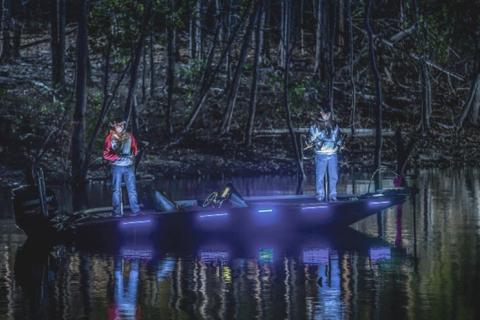
For many anglers, summer crappie fishing conjures up memories of the whip-poor-will's call and starlit nights. You can catch hot-weather crappie during daylight hours, especially during cloudy periods or when water is muddy. But the odds for success improve if you fish the hours between dusk and dawn. During summer, many crappie work the late shift, and crappie anglers should, too.
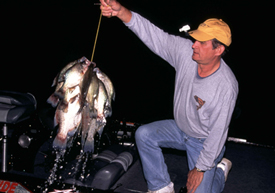
These ten night fishing tips can help you score on nighttime slabs.
1. Plan for Fishing Action
Thorough pre-trip planning can spell the difference between a good night-fishing trip and a bad one.
First, plan where you'll fish. The best night-fishing lakes are generally deep, fairly clear and exceed 500 acres. They're fertile, support abundant baitfish and have a good mix of structure and cover with areas of open water adjacent structural elements.
In small, shallow waters, summer crappie fishing is generally poor. Crappie have no cool, oxygen-rich depths to which they can retreat. If water conditions are really bad, they become semi-dormant. They may scatter to conserve oxygen. Fishing suffers.
Tip: The Highs and Lows of Crappie Fishing

Picking a good lake using these guidelines isn't foolproof. But by coupling this information with a few questions to the right individuals (state fisheries personnel, crappie anglers, tackle shop owners, etc.), you can narrow the field to a few choice waters.
You also should plan for the unique conditions encountered when night-fishing. Make sure running lights on your boat are working properly. Carry a flashlight or spotlight to signal your presence to other boats. Wear a life jacket and kill switch.

Organize gear before leaving home. Clean out unnecessary equipment. Have poles rigged and ready to go. Organize your fishing tackle box or bag. Recharge batteries for sealed-beam lights. Carry extra lantern fuel and mantles, anchors with an adequate length of rope to hold your boat stationary, marker buoys to pinpoint fishing holes and insect repellent.
2. Plot the Right Fishing Spot
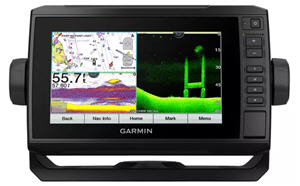
Know exactly where you'll fish when darkness falls. Prospect during daylight hours, and be sure you can find each fishing spot after nightfall if you leave and return. Select alternate sites in case of a change in plans.
If possible, study a bottom-contour map of the lake. Most summer crappie congregate in deep, open water near break-lines (areas where there's a sudden change in depth on the lake bottom), so look for elevation markings indicating deep-water ledges, creek and river channels, points, ridges and humps.
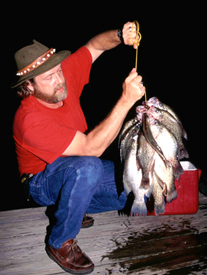
The map directs you to a likely position, then a marine sonar unit pinpoints break-lines. The drop-offs are then checked with a fish finder like the Garmin ECHOMap UHD 74cv Fishfinder / Chartplotter combo to locate crappie-attracting cover (stumps, treetops, brushpiles, etc.) and the crappie themselves.
After spotting crappie on sonar, use marker buoys like the Bass Pro Shops Marker Bouys to mark the site. This enables you to fish in the most productive water without straying off.
3. Structure Your Crappie Fishing Success
Crappie in most prime summer lakes will be near deep underwater structure. Some structures, however, are better than others.
Inundated stream channels are among the best. Start at the mouth of a major tributary, then troll back and forth across the area, using sonar to follow the edge of the channel drop while looking for humps, points, bends, lines of timber and other structure that concentrates fish. Outside bends and junctions of two channels are blue-ribbon hotspots.
Summer crappie also orient to pilings and submerged rip-rap beneath bridges crossing deep water. With sonar, you can ease along the piers and spot fish concentrations while also pinpointing the depth of the fish. Without sonar, it's still a simple matter to pinpoint fish around bridge structures by fishing various depths and structures.

Bluffs and steep points also rate high for night-fishing. When moving from deep water to shallower reaches at night, crappie prefer sticking close to structures leading from one area to the other. It's like a blindfolded person grasping a string that serves as a guideline. Without the string, there's no reference point when moving around. Bluffs and points are crappie's after-dark guide lines and almost always prime night-fishing spots

Although usually in shallow waters, lighted docks and marinas are also first-rate night-fishing spots. Overhead lights attract flying insects and baitfish, and many dock owners place crappie-attracting brushpiles nearby.
4. Follow the Fish
When fishing during early and late summer, track crappie's movements. Immediately after spawning, crappie usually are on structure leading from shallow bedding sites to deep-water summer haunts, structures like secondary stream channels and long sloping points. As summer wanes and day-length shortens, they make short forays between deep and shallow water, again using travel lanes like points, but also using shorter routes on humps, bluffs and other steep structure. In mid-summer, they'll be near the thermocline adjacent deep structure.
Follow the fish. Know where they're likely to be when you start your search.
5. Fish With the Right Night Light
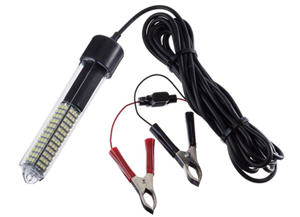
LED Fishing Light
Some night-fishing anglers use only fuel-powered lanterns like those made by Coleman. Others use only floating or submersible fishing lights. Smart anglers use both and use them correctly.
Hanging lanterns attract insects which attract baitfish which attract crappie. This isn't an instantaneous process, of course, so give it time to work.

Use at least two lanterns positioned on the same side of the boat so insects don't fog around your head. Hang them close to the water's surface from a boat-mounted lantern holder or tied to overhead objects. This provides light for tying knots, hooking bait and unhooking fish.
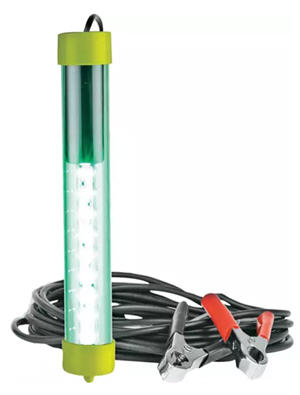
Submersible
Fishing Light
Sealed-beam lights have a styrofoam flotation ring. They're an added attraction for fish but not bugs because the headlight-like beam points down in the water. The light helps concentrate baitfish and crappie. Power is from a pair of alligator clips to the battery or a cigarette-lighter plug. Position each light so you can fish in or around the beam.
Submersible fishing lights are made to sink beneath the water's surface and light up the depths below. These, too, are good additions to your night-fishing setup. Bass Pro Shops has a portable underwater LED fishing light. The soft green light is proven to attract plankton, which draws in baitfish, which brings in crappies and other predators looking for an easy meal. Connects to any 12-volt battery via a 17-ft. long waterproof cord with alligator clips.

Black (ultraviolet) lights are another useful night-fishing aid. They make fluorescent monofilament glow, allowing easy bite detection. Several models that run off 12-volt systems are available.
6. Two Fishing Rigs are Better Than One

When you start fishing, it's hard to tell where crappie are in relation to your lights. Having several rigs in the water (where law permits) helps pinpoint them.
Place one rig near a light and others spaced along the length of the boat. Often the best area is near the light. At other times, crappie bite better on the fringes. This may indicate there's structure near the place they're biting and none where there's no action. Moving the lights or boat to get positioned more directly over the fish may help.
7. Get Your Fishing Bait Down to the Fish
Until you determine the crappies' preference, set baits at different depths using water clarity as a guide. If the lake is clear, crappie may be at 20 to 30 feet; in stained water 10 to 20 feet, and in muddy water 5 to 10 feet. Remember, however, your lights will draw the fish closer to the surface. The key is to get your bait down to the level where fish are feeding but not beneath or above the strike zone. If you start with rigs at different depths, figuring the pattern is easier.
8. Look at Your Fishing Hook

Hook Assortment
The biggest mistake most crappie anglers make is using a hook that's too big or one with a strong, stiff shank. When these hang on branches or other cover, you disturb fish in the cover and may break your line trying to get unsnagged.
Light-wire fishing hooks not only keep minnows alive and active, they also hook crappie firmly and can be straightened when they hang. Carry plenty of fine-wire Aberdeen fishing hooks like the Bass Pro Shops Aberdeen or Gamakatsu Crappie hooks in different sizes for a range of bait and crappie sizes.
9. Mark Your Fishing Equipment to See it in the Dark
The biggest problem when night-fishing is seeing your equipment, but a can of fluorescent paint can be used to mark equipment for easy visibility. You'll be surprised how much easier it is to see a bright yellow bobber than a white one. A splotch of glowing paint in a tackle box compartment eliminates the painful experience of sorting hooks by Braille. A stripe of fluorescent color on black needle-nose pliers thwarts their usual invisibility. Painting a black rod tip helps in detecting light biters.
The benefits are compounded when you use black lights. Look for special paints at craft stores that glow under ultraviolet.
10. Serve a Crappie Bait Buffet
Jigs and minnows are the best crappie baits, day and night. But at times it pays to vary the menu for discriminating nighttime diners.
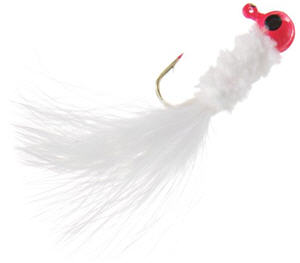
Jig
If crappie are feeding on shad attracted to your lights, shad may outproduce minnows. Where legal, catch them with a dip net or cast fishing net, then clip the tail or fins to give them an erratic, "crippled" action. Crappie can't resist.
Swarms of mayflies may be attracted to your lights. And at times, crappie gorge on the mayflies while refusing baitfish. Be watchful for such phenomena and act accordingly.

Among artificial bait, small jigging spoons and crappie spinners compete with crappie jigs. When allowed to fall on a slack line through schooling baitfish beneath your lights, they'll quickly garner a bite from opportunistic crappie.
In summer, crappie bite at night everywhere they're found. The key to catching them is knowledge of their summer habits and versatility. If one location or tactic doesn't work, try another. If that doesn't work, try again. Sooner or later you'll discover the true joys night-fishing offers.
- 91279 views

